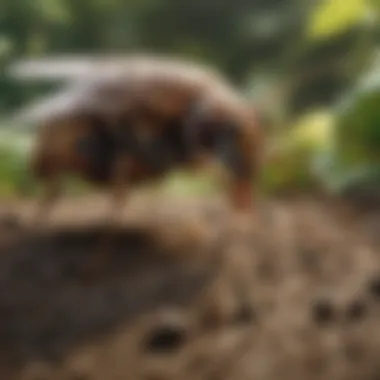Understanding Triazicide: Safety for Pet Owners


Intro
In the realm of pest control, the choice of product can have significant implications not only for effective management but also for the safety of household pets. Triazicide insect killer stands out among various options due to its specific formulation and efficacy against a range of pests. However, pet owners must consider a multitude of factors regarding its use. Understanding Triazicide's active ingredients, how it operates, and the potential risks to pets is crucial for making informed decisions. This article aims to provide a thorough exploration of these aspects to help pet owners maintain a balance between effective pest control and the well-being of their animals.
Key Concepts and Terminology
Basic Definitions
Triazicide refers specifically to a class of pesticides that contain active ingredients, such as triazines, which target certain insects that are harmful to plants. Primarily, it works through contact and ingestion methods. Understanding the chemical properties of Triazicide and how they interact with insects can reveal much about its effectiveness and safety.
Historical Context
Historically, the development of insecticides has witnessed several advancements, with Triazicide emerging as a more refined option. As gardeners became increasingly aware of the implications of pesticide use, especially regarding safety for pets and humans, crafting formulations like Triazicide became essential. Its introduction aimed to reduce toxicity while maintaining effectiveness.
Recent Innovations and Trends
Technological Advancements
Recent years have highlighted innovations in pesticide technology, including the encapsulation of active ingredients for reduced volatility and improved targeting. This not only enhances pest effectiveness but also minimizes harmful exposure to pets and the environment.
Sustainable Practices
With growing awareness around ecological footprints, sustainable practices are now guiding pesticide usage. Triazicide formulations are increasingly aligned with integrated pest management (IPM) strategies that emphasize eco-friendliness and reduced chemical reliance. Educating users about these sustainable approaches is critical for responsible pesticide application.
Practical Applications and Techniques
Step-by-step Guides
Using Triazicide involves adhering to specific guidelines for safe and effective deployment. Here is a general outline:
- Read the Label: Understand the specific instructions provided by the manufacturer before use.
- Prepare the Area: Remove pets from the targeted area to prevent accidental exposure.
- Application: Apply as directed, ensuring even coverage for maximum efficacy.
- Post-Application: Restrict access to the area for a specified time as indicated on the label.
- Clean-Up: Thoroughly clean any equipment used and dispose of any unused product responsibly.
Case Studies
Research and user experiences can provide valuable insights for effective Triazicide usage. Numerous case studies presented by agricultural extension agencies examined the application of Triazicide in various environments, focusing on pest management outcomes and safety evaluations. These studies underscore the importance of following guidelines strictly to mitigate risks to pets and achieve successful pest control.
"The careful application of insecticides can lead to a healthy balance between pest control and pet safety."
In summary, navigating the realm of pest control requires a well-rounded understanding of products like Triazicide, especially for pet owners. By recognizing key terminologies and innovations, as well as practicing safe application techniques, one can ensure both effective pest management and the protection of beloved animals.
Further exploration will delve into the details of Triazicide’s safety profile specifically toward pets, highlighting essential information that every pet owner should be aware of.
Intro to Triazicide
Understanding Triazicide is crucial for pet owners who seek effective pest control solutions without compromising their animals' safety. Triazicide is widely recognized as a powerful insect killer that plays a vital role in managing pest populations. However, knowledge about its safety profile is equally significant.
Pet owners often face the challenge of balancing effective pest management with the need to protect their furry companions. The goal of this section is to provide clarity on what Triazicide is and the contexts in which it is used, highlighting both its efficacy and the precautions that must be taken when using it around pets. Furthermore, recognizing the properties of Triazicide can enhance responsible usage while maximizing its benefits.
What is Triazicide?
Triazicide, a term commonly associated with certain insecticides, refers to various formulations designed to target specific pests. The active ingredients in Triazicide products typically include Triazine-based compounds, which disrupt the nervous systems of insects upon contact or ingestion. These compounds are effective against a wide range of common pests, making Triazicide a popular choice among homeowners and professional pest control services alike.
Beyond being a potent insect killer, Triazicide formulations are differentiated by their chemical compositions and specific application methods. They can be used in various environments, including residential gardens, lawns, and agricultural settings. It is the diverse application spectrum that adds to its appeal among users seeking quick and reliable results against pest infestations.
Common Uses in Pest Control
Triazicide is commonly employed in the management of several household and garden pests. These include:


- Ants: Effective against various ant species that invade homes and outdoor spaces.
- Grubs: Targets grubs that can devastate lawns and garden beds.
- Cockroaches: Provides control against these resilient pests that thrive in residential areas.
- Fleas and Ticks: Useful in preventing these parasites that may harm pets.
In addition to these specific uses, Triazicide is often employed in preventive treatments. For instance, applying Triazicide to lawns before the onset of pest season can help keep infestations at bay.
Moreover, its versatility extends to commercial applications, where it is used in landscaping and agricultural sectors to protect crops from various insect threats. Overall, understanding the different contexts in which Triazicide is utilized enhances a pet owner's ability to make informed decisions regarding its application while ensuring the safety of their pets.
Composition of Triazicide
The composition of Triazicide insect killer is crucial for understanding its effectiveness and safety, especially for pet owners. Knowing what goes into these pesticides helps inform decisions regarding pest control methods that align with animal welfare. The interplay of the active ingredients and other components in Triazicide contributes not only to its pest-fighting abilities but also to its potential risks for pets.
Active Ingredients Explained
Triazicide contains several active ingredients, with the most prominent being triazole compounds that work primarily to interrupt the lifecycle of target insects. These compounds include ingredients like Gamma-Cyhalothrin and Bifenthrin. Gamma-Cyhalothrin is effective against a wide range of insects, making it a popular choice for gardeners. Bifenthrin, on the other hand, targets specific pests while minimizing harm to beneficial ones.
It's essential to consider the concentration of these active ingredients as well. Different formulations may have varied concentrations, which can impact both efficacy and safety. Pet owners must be cautious, as even small amounts of these substances can pose risks to sensitive animals.
Chemical Properties and Mechanism of Action
Understanding the chemical properties of Triazicide helps clarify how it interacts with living organisms. These compounds disrupt the normal functioning of the insect's nervous system, leading to paralysis and death. The mechanism involves blocking sodium channels that are crucial for nerve impulse transmission.
In terms of persistence, these chemicals have a moderate to high residual effect, meaning they can remain active in the environment for some time. This can be both beneficial and problematic. While it ensures long-term pest control, it also raises concerns about exposure to pets and non-target species that might come into contact with treated surfaces.
"Continuous exposure to chemical components in pesticides can lead to cumulative toxicity in pets, making it vital for pet owners to apply these products with caution."
The knowledge of how these chemical properties influence the behavior of pests and the potential risks to pets aids in making well-informed choices regarding pest control strategies. Understanding Triazicide's composition is an essential step for responsible gardening and pet ownership.
Safety for Pets: A Critical Overview
The safety of pets during the application of Triazicide insect killer is a crucial theme within this article. Understanding the risks and protective measures associated with this chemical product is essential for any pet owners who engage in pest control activities. The need for vigilance stems from the potential hazards certain chemical substances can pose to household animals, especially when they are frequently in close proximity to treated areas.
Careful consideration must be given to the risks associated with Triazicide. While effective against insects, its safety profile has sparked concern among pet owners. It is important to assess the potential for accidental exposure and understand how it can affect pets. By evaluating toxicology research and examining real-life incidents, pet owners can make informed choices regarding pest control methods that protect their pets.
Toxicity Levels in Common Pets
The toxicity levels of Triazicide can vary among common household pets, such as dogs, cats, and small mammals. The specific active ingredients in Triazicide, including the behavior of these substances in the pet's body, determine the potential danger level.
Research indicates that certain pets are more sensitive to chemical exposures. For example, cats often lack certain liver enzymes that help to metabolize toxins effectively, thereby increasing their susceptibility to poisoning. Dogs, on the other hand, may experience toxicity based on size and breed. Small dogs might show symptoms faster than larger breeds due to their physical size.
Signs of toxicity in pets may include:
- Vomiting
- Diarrhea
- Lethargy
- Excessive salivation
- Seizures (in severe cases)
If any of these signs are observed after pest control application, immediate veterinary advice should be sought. Understanding the specific risks can lead to better preparations and precautions.
Risk Factors and Variables
Multiple risk factors influence the level of danger that Triazicide poses to pets. One key variable is the method of application. Spraying activities in enclosed spaces may increase the concentration of chemicals in a closed environment, enhancing the chances for exposure. Wind speed and direction should also be taken into consideration during outdoor applications, as they can carry chemical particles into unintended areas, potentially affecting pets nearby.
Another factor is the duration of exposure after the application. The time it takes for the treated area to be safe for pets directly correlates with the formulation of the insecticide and environmental conditions. Each product has specific guidelines about when pets can safely re-enter treated areas.
Finally, the habits of the pet play an important role in risk assessment. Pets that tend to explore outdoors or have a habit of sniffing or licking surfaces may be at higher risk than more passive pets.
Responsible pest management requires not only an awareness of products used but also a commitment to ensuring pet safety throughout the entire process.
Regulatory Standards and Safety Guidelines
Regulatory standards and safety guidelines play a crucial role in the responsible use of Triazicide insect killer, especially for pet owners. Understanding these regulations can significantly impact the health of pets and the environment. Various organizations, including the Environmental Protection Agency (EPA), are involved in establishing guidelines that ensure the safe application of pesticides. These standards help mitigate risks associated with pesticide exposure, particularly for vulnerable populations like pets.


The benefits of adhering to these standards are far-reaching. They not only protect pet owners from potential liabilities but also promote sustainable pest control practices. By following established safety protocols, pet owners can minimize the risks of toxicity both to their animals and to non-target organisms. Having a clear understanding of these regulations can thus empower pet owners to make informed decisions regarding pest control methods.
In addition, awareness of regulatory guidelines fosters a culture of safety and responsibility. It encourages individuals to remain operating within boundaries that prevent adverse effects on human and animal health. Overall, knowledge of regulatory standards can lead to better pest management practices that are both effective and responsible.
EPA Regulations on Pesticide Use
The EPA has set forth comprehensive regulations concerning the use of pesticides, including Triazicide. These regulations focus on ensuring the safety and efficacy of pesticide products while balancing agricultural needs and environmental protection. Before a pesticide is marketed in the United States, it undergoes rigorous review by the EPA, which evaluates its potential impact on human health and the environment.
The regulations cover various aspects including:
- Labeling Requirements: Clear instructions on pesticide usage, including safe handling and application practices, are mandatory. Pet owners need to closely follow label instructions to ensure safe use.
- Pesticide Registration: All pesticides must be registered and approved by the EPA before they can be sold commercially. This process includes an evaluation of the chemical's effects on pets and the environment.
- Post-Marketing Surveillance: After approval, the EPA engages in ongoing monitoring of pesticide effects. This often includes gathering data on incidents involving pets and potential exposure risks.
Overall, the EPA's regulations ensure that products like Triazicide are used in a manner that safeguards both pets and the ecosystem.
Label Instructions and Safe Practices
Label instructions are essential guidelines provided by manufacturers of pesticides, including Triazicide. They are a critical source of information that can prevent dangerous misunderstandings during application. Each product label includes specific information about usage, including the correct dosages and application techniques that must be followed.
Key components of label instructions include:
- Dosage Guidelines: Following the recommended amount prevents over-application, which can lead to increased toxicity for pets and environmental harm.
- Application Timing: Labels often specify the best times for application, such as avoiding high winds or rain, which can affect the efficacy of the product and exposure risks.
- Safety Precautions: Pet owners must pay attention to sections that indicate necessary protective gear during application, including gloves and masks, to safeguard against any potential exposure.
Following label instructions is not merely a recommendation; it is a requirement to ensure the health of both pets and humans.
In practicing safe pest control, recommendations include:
- Securing pets indoors during and immediately after application to avoid exposure.
- Not applying pesticides in areas where pets frequently roam unless otherwise specified on the label.
- Monitoring pets for any signs of adverse reactions after pesticide application to catch any toxicity issues early.
In summary, thorough knowledge of label instructions and following safe practices is vital for any pet owner using Triazicide. This knowledge contributes to healthier environments for pets and successful pest management.
Environmental Impact of Triazicide
The environmental impact of Triazicide is crucial for understanding its broader implications, particularly when used in gardens or agricultural settings. This section will cover how Triazicide can affect ecosystems, as well as the importance of awareness about these impacts for pet owners and those interested in sustainable pest control.
Effects on Non-Target Organisms
Triazicide, while effective against common pests like ants and mosquitoes, has notable consequences for non-target organisms. Non-target organisms include beneficial insects such as honeybees, butterflies, and certain beetles. Understanding these effects is essential. When Triazicide is applied, it can lead to the unintended death or distress of these vital species, ultimately affecting pollination and the overall balance of local ecosystems.
Research shows that exposure to Triazicide can disrupt the habits and behaviors of non-target insects. They may suffer from impaired flight abilities or changes in foraging behavior, which decreases their survival chances. Moreover, these disturbances can cascade through the food chain, affecting birds or other animals that rely on these insects as a food source. It is vital to consider this when applying Triazicide, especially during flowering seasons when beneficial insects are actively foraging.
Soil and Water Contamination Concerns
Another significant concern regarding the environmental impact of Triazicide involves potential soil and water contamination. When Triazicide enters the soil, it can bind to soil particles, making it difficult for it to break down quickly. This persistence raises concerns over groundwater contamination.
It is possible for Triazicide to leach into nearby water sources, especially after heavy rainfall. Consequently, it can pose risks to aquatic life. Fish and other organisms in these water bodies may exhibit harmful effects from exposure, disrupting aquatic ecosystems.
Pet owners must understand these risks when contemplating the use of Triazicide in outdoor spaces. By taking measures to prevent runoff and applying the product responsibly, one can mitigate negative impacts on both soil health and water quality.
Safe Application Techniques
Safe application techniques form the backbone of responsible pest control. When dealing with chemicals such as Triazicide, comprehension and execution of proper methods ensure safety for both pets and the environment. This section highlights critical elements like timing, protective gear, and post-application measures.
Timing and Weather Conditions
Timing the application of Triazicide is vital for effectiveness and safety. Optimal times are typically early morning or late evening, when pets are less active outside. Applying it under stable weather conditions reduces risks of drift and runoff.
Consider avoiding windy days or rainy forecasts. Wind can carry the pesticide away from the targeted area, whereas rain can wash it into unintended sites, possibly harming pets. Hence, always check local weather conditions before proceeding with application.


Weather factors, such as temperature and humidity, also affect the pesticide’s efficacy. High temperatures may increase evaporation, while high humidity can enhance the chemical's absorption into the environment. Thus, applying with awareness of these conditions can protect both the user’s health and the well-being of pets.
Using Protective Gear During Application
The use of proper protective gear is paramount during the application of Triazicide. This includes gloves, long sleeves, and masks to minimize direct contact with skin and inhalation of fumes. Protective gear acts as a barrier between the chemical and the applicator.
Clothing treated with a water-resistant agent may provide an additional layer of defense. It is essential to adhere to all manufacturer instructions regarding protective equipment, which ensures compliance and enhances overall safety.
In addition to personal safety, ensuring pets are secured away from the treated area during application is crucial. This prevents accidental exposure, safeguarding their health.
Post-Application Safety Measures
Once the pesticide has been applied, post-application safety measures are critical. First, it is advisable to wait for a specified time (as indicated on the product label) before allowing pets in the treated area. This waiting period allows the chemical to settle and minimizes potential exposure.
Regularly checking the treated area for any signs of chemical runoff is also wise. If rain occurs shortly after application, ensure to assess if the area remains safe. If needed, repeat the application process based on guidelines to maintain pest control without compromising safety.
Monitoring pets for any unusual behavior after restoration to the treated space is important. Observing for adverse reactions can help in quick identification of any potential impacts.
"Adhering to safe application techniques ensures maximum effectiveness while protecting pets and the environment."
Alternatives to Triazicide
As the quest for effective pest control continues, many pet owners look for safer options that do not compromise the wellbeing of their animals. Alternatives to Triazicide insect killer are increasingly relevant in modern gardening and pest management. Choosing alternatives ensures that our pets remain safe while still effectively managing pest populations. Understanding these options requires a focus on their benefits and considerations, as well as their ecological impact.
Natural Pest Control Options
Natural pest control methods offer a promising approach for those concerned with the health of their pets and the environment. These methods can be effective while minimizing the risks associated with synthetic chemicals.
Here are some common natural control options:
- Diatomaceous Earth: Made from fossilized algae, this powder can be spread in gardens to kill soft-bodied insects by dehydrating them without harming pets.
- Neem Oil: Derived from the seeds of the neem tree, this oil disrupts the life cycle of pests and is regarded as safe for pets when used according to instructions.
- Essential Oils: Certain essential oils, such as peppermint and citronella, are known to repel pests. However, it is crucial to ensure these oils are used in a pet-safe manner.
- Beneficial Insects: Introducing natural predators like ladybugs can help control pest populations without any harm to pets.
While these options may take longer to show results compared to chemical solutions, their safety profile is a significant advantage, especially for pet owners.
Pet-Friendly Insecticides
For those who prefer not to use natural methods, pet-friendly insecticides are a viable alternative to Triazicide. These products are designed to effectively target pests while minimizing toxicity to pets and humans. When selecting an insecticide, consider the following factors:
- Active Ingredients: Look for insecticides that use ingredients like insecticidal soap or pyrethrin. These are generally safer for pets.
- Absence of Harmful Additives: Avoid products with known harmful additives or ingredients. Always read labels carefully before application.
- Pesticide Concentration: Lower concentration products may be less harmful, giving you better options for use in pet-heavy environments.
Certain brands, such as EcoSMART Organic Insect Killer and MDX Concepts Grub Control, focus on the dual goal of pest control and safety for pets, making them excellent choices for concerned caretakers.
"Opting for pet-friendly insecticides demonstrates a commitment to safe pest management practices while caring for your furry friends."
The End: Making Informed Choices
Making informed choices regarding pest control is vital, especially for pet owners. The safety of our pets should always be a priority, yet the necessity to control pests is an equally important concern. By understanding the details surrounding Triazicide insect killer and its implications, pet owners can navigate the challenges of pest control effectively. This section wraps up the critical considerations laid out in the article, highlighting the importance of knowledge and awareness in making safe decisions.
Summary of Findings
Throughout this article, we examined Triazicide in great detail. The active ingredients, particularly the influence of the chemical components on our pets and the environment, were discussed extensively.
- The toxicity levels are a significant worry, especially for common household pets like dogs and cats.
- Various risk factors, such as age, breed, and overall health of the pet, can affect their susceptibility.
- Additionally, the environmental impact was dissected to understand the importance of safe application.
The regulations and safety guidelines set by the EPA were evaluated to provide clarity on the lawful application of Triazicide. It was found that adhering strictly to label instructions mitigates many risks associated with pesticide use.
Final Recommendations for Pet Owners
To ensure the well-being of pets while effectively managing pest issues, pet owners should:
- Educate Themselves: Familiarize with the active ingredients and their potential effects on pets.
- Evaluate Alternatives: Consider using pet-friendly insecticides or natural pest control options before resorting to Triazicide.
- Apply With Caution: Always follow the safety guidelines provided on the product label.
- Monitor Pets Closely: After applying any insecticide, ensure pets do not access treated areas until it is safe.
- Consult Professionals: When in doubt, reach out to pest management professionals or veterinarians for tailored advice regarding their specific pets.
By making informed decisions and knowing the right practices, pet owners can balance pest control needs without compromising the safety of their beloved animals.















